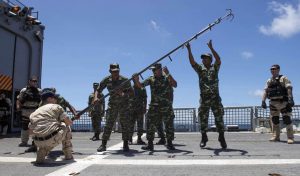The United States and the tiny Indian Ocean islands of the Maldives concluded a defense agreement on September 10. A U.S. Defense Department press release notes that “Framework for U.S. Department of Defense-Maldives Ministry of Defence Defense and Security Relationship” signifies an “intent to deepen engagement and cooperation in support of maintaining peace and security in the Indian Ocean, and marks an important step forward in the defense partnership.”
While significant in itself – India and the U.S. have long watched the islands being drawn towards China with growing alarm – what is exceedingly interesting is that the U.S. decision to deepen military ties with the Maldives was taken in consultation with India, which has long expressed discomfort with the idea of extra-regional powers meddling in its backyard. The Hindu noted yesterday that India has not only welcomed the agreement, but that U.S. officials had shown a draft copy of the U.S.-Maldives agreement to Indian representatives in Male.
Under the former Maldives President Abdulla Yameen, relations between India and the islands hit rock bottom in early 2018, when Male decided to first impose – and then extend – an internal emergency in the Maldives to tame the opposition amid his government’s growing closeness with China. That had led many prominent analysts in India to call for direct Indian military intervention there. And there is indeed a precedent for such action: in 1988, the Indian military launched a special-forces operation to prevent a coup against then Maldives president Maumoon Abdul Gayoom, who was also jailed during the 2018 emergency. Whether China directly backed Yameen’s intransigence is not known, despite speculations that it had militarily signaled to India its intent to stand by him.
With the election of Ibrahim Mohamed Solih as president in September 2018, India-Maldives relations have grown considerably warmer, as the Maldives has reiterated its “India First policy” both in word and action. While the Maldives continue to battle a debt problem driven by loans the country took from China under the Yameen regime, Solih has taken steps to bring his country visibly closer to India. In June last year, soon after his reelection as India’s prime minister, Narendra Modi’s first visit was to the Maldives, where he inaugurated a coastal surveillance radar system designed to enhance India’s maritime domain awareness.
India has considerably softened its stance on the involvement of extra-regional powers in the Indian Ocean in the last three years. Note that as late as April 2017, Indian military doctrines were expressing concern about “the presence and role of external actors” (note the plural) in the Indian Ocean, a stance inherited from the Cold War era, where India simultaneously fretted about Soviet as well as American naval presence, especially towards its end, in the region. However, in the past couple of years New Delhi has considerably warmed up to partnering with others in the Indian Ocean, including powers like France whose presence in the region are a result of its colonial legacy, something that would have been a no-go in the past given India’s historic anti-colonial stance.
That this is a result of China’s push into the Indian Ocean is obvious. But as Brookings’ Tanvi Madan tweeted yesterday, it also fits a historic pattern in Indian foreign policy since the country’s independence, whereby whenever China has thrust itself in what India has perceived to be its own sphere of influence, New Delhi has welcomed a greater role for the U.S. and other powers.
It is clear that India is enthusiastically embracing a networked Indo-Pacific architecture, principally for structural reasons – both China’s growing power projection capabilities, and India’s fear of diminishing U.S. power – that have led it to focus on smaller balancing groupings such as the U.S.-Australia-Japan-India quad or the India-Australia-France trilateral. But the relations and dynamics between these various outside powers could have unpredictable effects for New Delhi.
India and Russia are in the final stages of signing a military logistics agreement along the lines New Delhi already has with Washington, Canberra, and Tokyo (among others). Since last year, India and Russia have also been promoting a Vladivostok-Chennai maritime route. Should both materialize – and like many things India-Russia, the ‘should’ remains operative – the question of whether the U.S. will welcome a greater Russian naval presence in the Indian Ocean even as it ramps up its own relations with others in the region, like the Maldives, remains to be answered.

































